From Activity-based AAC to Robust Language: Part 2
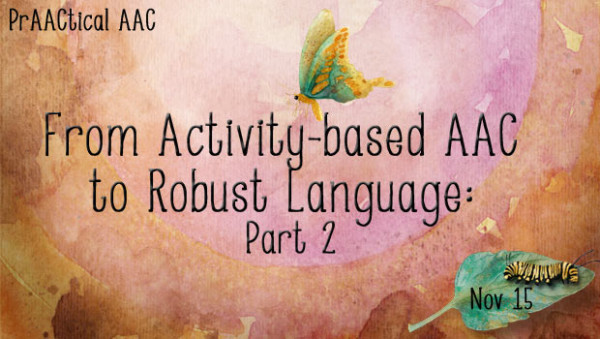
Last week, we talked a bit about activity-based communication displays (ABCDs), and the role they play for AAC learners. The analogy of feeding someone (with ABCDs) versus teaching them to fish for themselves (with robust AAC), resonated with many of you.
In some cases, ABCDs can be a good way for therapists, educators, and families to take steps forward in their implementation of AAC. They allow students with little or no functional speech a way to participate in activities by making choices and comments, and that is a very good thing for those who don’t have a better option.
There are a few drawbacks to ABCDs, though. Here are some of them.
- ABCDs limit language development. The learner can only experience the exact words and configurations that appear on a particular display. The learner has no way to expand his/her utterance by including other words or concepts.
- ABCDs are time-consuming to develop. Basically, you have to make one for every activity in which the learner participates. The ABCD I downloaded for making a jack-o-lantern last month isn’t much help to me in our Christmas ornament art project.
- ABCDs aren’t very functional. AAC learners need to communicate from sunrise to sunset, but ABCDs only work for one specific activity. What is the learner supposed to do for the rest of the day?
- ABCDs slow down the learning process. With each ABCD, there are new words to hunt for and that takes time and effort. It is hard to build automaticity under those conditions, so the learner has to consciously process all of the words that they say. “What’s so bad about that?” It’s s-l-o-w and exhausting, for starters. Anyone who has travelled to a place where they know only a little bit of the language has experienced the fatigue that sets in whenever they try to ask for directions, order a meal, or buy train tickets. A little bit is fine, but imagine having to communicate under those conditions all day, every day. I don’t know about you, but, in those situations, I get worn out and shut down pretty quickly. And that leads others to judge me as less-than-competent, snobby (for not trying to speak the language), or just annoying (who has time for this?!!).
Still, ABCDs can be a great way for some teams to dip their toes into AAC waters. That’s huge. I have a TON of respect for those therapists, teachers, aides, and family members who are willing to take this step, and even more for those who challenge themselves to keep growing.
How can we move beyond this to a more robust AAC system? Here are a few thoughts.
- Reflect. Give yourself time and head-space (if that is a word) to think it over. You don’t have to rush into anything. Consider the drawbacks of ABCDs as they apply to the AAC learners you serve. Mentally review the next steps in language development for those individuals. Given that they can now do ___, what’s next? What AREN’T they yet using their AAC to say that we can help them with? Where is all this leading, from a language development point of view?
- Explore more robust AAC options. There are lots of those, of course, so get Googling. Even better, work with the team to get ahold of some to explore.
- Consider starting with a core vocabulary communication board, book, app, or SGD.
- Integrate old and new. Use the ABCDs you already have along with the new (more robust) AAC materials.
“But I have some awesome ABCDs. What should I do with them?”
This is the time to get creative. Now that we have a new perspective (teaching them to fish with true language development rather than feeding them with ABCDs), we can look at our ABCD materials with that lens. Rather than tossing our old friends aside, we can reimagine them and their role in AAC. Here’s what I mean.
Let’s say that that we’ve been using some of the ABCDs from the wonderful team at Miami-Dade Preschool Exceptional Student Education Program.
One option is to move completely away from activity-specific vocabulary to a communication board/book, app, or SGD that has a strong base of core words. The beauty of core vocabulary is that it can apply to any situation (see this example). Some teams may want to tackle the transition in one giant step, but that may be overwhelming and a bit disorienting for most. If we’re ready to take a step toward more comprehensive language but want to do it more gradually, we might:
- Identify some initial core vocabulary displays that might work for our learners. Based on our learners’ needs we might download existing communication materials and personalize them for our setting or create our own.
- Use the core vocabulary in conjunction with the existing ABCDs. We can keep them side-by-side initially and use words from each in our modeling and instruction.
- Cut apart the symbols from the ABCD and place them in a strip at the top of a core language board (like in a flip book), or around the perimeter.
- Use a communication aid (board, book, screen, overlay) that combines the best of both worlds. Tabi Jones-Wohleber’s Classroom CORE (Communication Opportunities Ready to Engineer) Book, shared earlier in the year, is one example of this. The AT Team at Orange County Public Schools has a trifold board that uses this approach, too. We can modify the files of our existing ABCDs to change the size so that they fit into the new core system we’ve selected.
- Use them in conjunction with a full-featured AAC app or SGD. Already have AAC technology, either for a specific student or on a shared classroom device? Check to be sure you have the latest operating system and version of the software or app, as some have really enhanced their options for core vocabulary. Choose a page set/vocabulary that best matches the core language needs of your students.
- Use the ABCDs for a completely new purpose. Instead of using them as communication aids, you can make instructional materials out of them. Think Lotto or Bingo games, scavenger hunts, or vocabulary collages. Once you get started, you’ll come up with lots of ways to incorporate robust language learning (e.g., building core word usage, expanding MLU, sentences with prepositions, etc).
ABCDs are a wonderful stepping stone in AAC implementation and can serve as a wonderful platform for building communication that goes beyond requesting, commenting, and labeling. Have you repurposed ABCDs for the AAC learners you work with? Do you have strategies for moving forward into more robust language with students who are learning AAC? We’d love to hear about them.
Filed under: PrAACtical Thinking
Tagged With: activity-based intervention, language intervention
This post was written by Carole Zangari
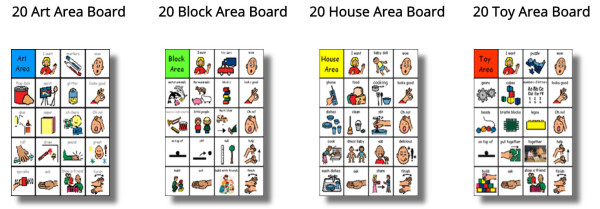

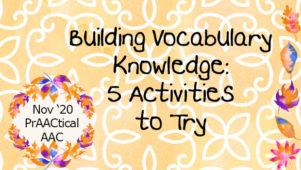
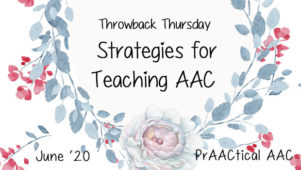
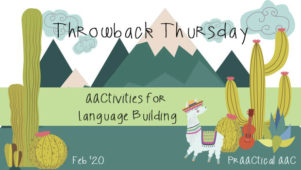
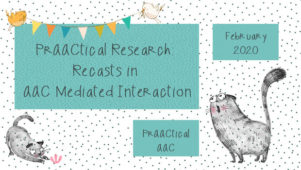
4 Comments
HI Carole – I love this post and the previous one. I also use ABCDs as a starting point before moving onto robust AAC systems – although usually only because the team needs to learn to feel more comfortable about aided language stimulation and supporting AAC, not because I believe it’s a good place to start. I love using the CHAT-now resource as a source for ABCDs for two reasons. 1. It has a fabulous “generic” display with high frequency words that gets used whenever an activity specific display isn’t available. This means people get in the habit of AAC all day, every day – and it gives a small amount of language that can be used across all activities. 2. The other reason is because most of the situation specific displays are the same as the situation displays in PODD. So – if an individual becomes very familiar with the play dough display in CHAT-now and then they progress to a PODD, a very similar page is in the PODD which means that the learning done with the ABCDs transfers across.
I also love your acronym of ABCDs – I’ve never heard them called that before and I’m definitely using it in the future 🙂
Thanks again for sharing your thoughts on this.
Jane
I usually suggest that teachers keep the ABCDs in the correlating play area of the classroom. (And that they keep the displays with the core words in the same location all the time)
Thank you so much for this informative post! Do you know of any peer reviewed comparison studies of Activity Based Communication Displays and CORE Vocabulary approaches to language development? Or ones that examine ABCDs for language development in general?
It’s challenging to look up because of the great variety in what ABCDs are called in different settings. I’ve heard ‘topic displays’, ‘conversation displays’, ‘topic based communication displays’ etc. etc.
Thank you in advance!
Paul, I haven’t seen comparative research on this. You’re absolutely right that they get called different things by different people. :/